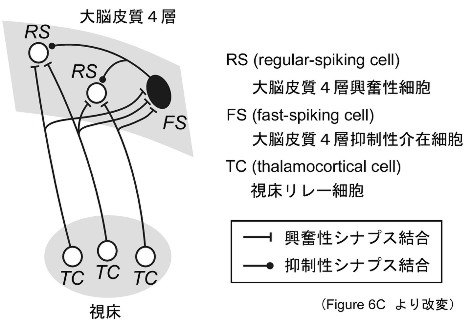感覚情報は、視床を経由し、大脳皮質へと運ばれる。体性感覚経路において、視床リレー細胞 (thalamocortical cell) は、大脳皮質4層における興奮性細胞 (regular-spiking cell) とある種の抑制性介在細胞 (fast-spiking cell) と機能的に結合していることがこれまで分かっていた。本研究では、複数の視床リレー細胞が複数の大脳皮質4層細胞と機能的にどのように結合しているのか、多対多の神経回路配線パターン(発散性と収束性)に関して検討した。視床と大脳皮質が連結したマウス脳スライス標本において、3つの大脳皮質4層細胞からの同時パッチクランプ記録下において、複数の視床リレー細胞の単一繊維刺激を行った。結果、以下の神経回路配線が明らかとなった:(1) regular-spiking cell に投射する視床リレー細胞は、近接した fast-spiking cell に非常に高い確率で発散的結合を形成していた。一方で逆はそうではなかった。(2) 複数の視床リレー細胞は、fast-spiking cell に収束し、複数の regular-spiking cell に抑制的に発散していた(図参照)。
Inoue T and Imoto K. Feedforward inhibitory connections from multiple thalamic cells to multiple regular-spiking cells in layer 4 of the somatosensory cortex. J Neurophysiol 96: 1746-1754, 2006.

Thalamocortical (TC) cells in the ventrobasal thalamus make direct excitatory connections with regular-spiking (RS) cells in layer 4 of the somatosensory cortex, but also make disynaptic feedforward inhibitory connections with the RS cells by layer 4 fast-spiking (FS) cells. In this study, we investigated connection rules of the feedforward inhibitory circuit from multiple TC cells to multiple RS cells, at the level of synaptic potentials. Using thalamocortical brain slices of young mice (postnatal days -), we made simultaneous patch-clamp recordings from three adjacent cortical cells (two RS cells and one FS cell), combined with minimal stimulation of presumed single TC fibers. We found that nearly all (97%) of TC fibers, which generated excitatory inputs onto RS cells, also generated divergent excitatory inputs onto adjacent FS cells. Some 44% of TC fibers generated divergent excitatory inputs onto adjacent pairs of RS cells. We then combined the triple patch-clamp recording with multisite (two to three) minimal stimulation of single TC fibers and found that 86% of FS cells received convergent inputs from all of the stimulated TC fibers. We also found that 68% of FS cells generated divergent inhibitory inputs onto adjacent pairs of RS cells. The results indicate that spikes in TC cells, which excite RS cells, also excite adjacent FS cells with high fidelity. The results also indicate that FS cells receive convergent excitatory inputs from multiple TC cells and then send divergent inhibitory outputs to multiple RS cells.